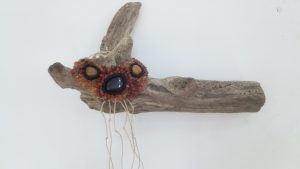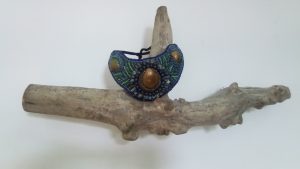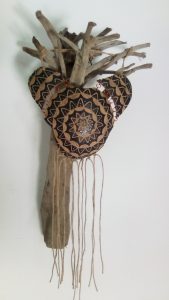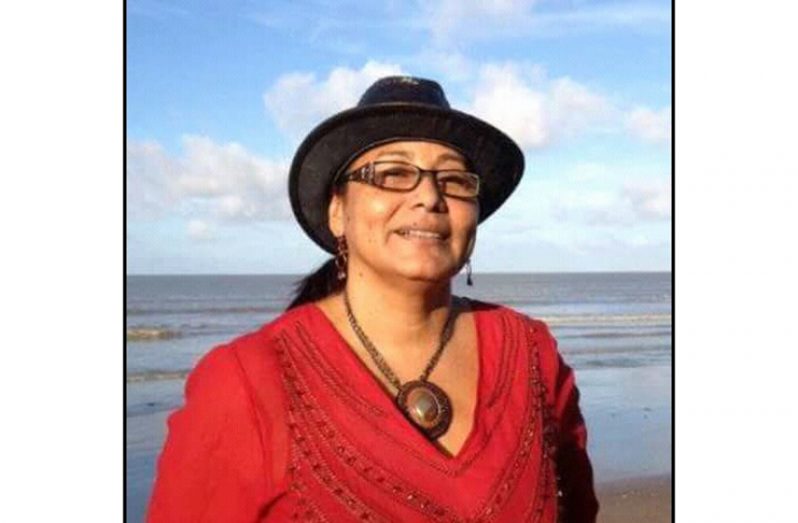By Gibron Rahim
IT IS undeniable that jewellery is created to be beautiful. However, pieces of jewellery, similar to pieces of art, can also convey messages. Jewellery is one way in which the history and culture of a people can be preserved and expressed. It is for this reason that Deborah Mathias’ handcrafted jewellery pieces, some of which were displayed at the recently concluded Heritage Art Exhibition, are as meaningful as they are beautiful.
Deborah Mathias is the creative force behind the brand Rave Designs. Mathias is one of the foremost designers in Guyana who use natural and repurposed materials, as well as locally produced semi-precious stones, to create jewellery. Mathias related to the Pepperpot Magazine that Rave Designs came out of the Quintex Advertising Agency, her father’s company. She worked alongside her father until his retirement when she assumed the reins. “Then at some point, I decided to take the company in a different direction in terms of being more artistic,” she explained. “And so we decided to go with Rave Designs which I think was a better description of the work we were doing.”

At that time the agency was focused mainly on costuming which Deborah noted is still part of the Rave Designs repertoire. She pointed out that costume work in Guyana is mainly done for Mashramani. It was during downtime between Mash seasons that Deborah decided to start designing jewellery to stay relevant. She related that she had already been designing jewellery as a hobby. “A lot of people were complimenting me on the jewellery that I wore and asked me to [design pieces] for them as well,” she stated. Deborah revealed that moving the jewellery designing aspect of the business to its own brand is currently under consideration, as it has reached heights of popularity in its own right.
Deborah has been interested in all the aspects and facets of craft since childhood. Her mother is a dressmaker while her father, as noted previously, worked in advertising. Of her mother’s work, she recalled, “I would always pay attention to the work that she was doing.” By chance, she grew up in a household where both her parents were involved in creative work which in turn nurtured her own creativity and interest in the area.
The length of time it takes to create the pieces varies. According to Deborah, the beadwork pieces take about a day. “But it depends on how much time you put into it within the day,” she was sure to note. That, she said, can be dependent on how long it takes the idea for the piece itself to develop. “Sometimes I develop it very quickly and I think it depends on how comfortable I am with what I’m doing at the particular time,” she explained.
“Sometimes it takes me days to feel comfortable with a piece and actually move forward.” Sometimes she even temporarily leaves a piece to work on another and then returns to the first one at a later time.
Deborah’s three jewellery pieces that were on display at the Heritage Art Exhibition were titled “Atlantis”, “Mayan” and “Pompei”. She noted that the names were chosen to reflect great ancient civilisations that inevitably fell, pointing out that it is quite likely that civilisations will fall in a similar manner in the future. She posited that it is possible that those ancient civilisations fell because they were not evolving in response to the changes occurring around them.

The concept behind the three pieces was “sustainable lifestyles in art”. That concept was based on the idea that indifference to our planet has led to the destruction of numerous ancient civilisations. That cycle can only be broken by learning to live in harmony with the planet as the Indigenous Peoples have done since ancient times. The three pieces on display were created using ethical methods and materials in an effort to raise awareness about living a sustainable lifestyle. They highlighted each of three areas where Guyanese need to embrace more sustainable practices, those that balance the use of resources with protecting the environment.
Atlantis represents the ethical harvesting and production of our ocean resources. The mainly seashell piece and its driftwood display speak to the use of found materials. Mayan represents the ethical harvesting and production of our agricultural resources. The coconut and calabash pieces speak to the use of natural foods, remedies and adornments. Finally, Pompei addresses the area of ethical harvesting and production of our mineral resources. That piece speaks to the fragile balance of the ecology in relation to the extractive industries that decimate the environment. The pieces altogether emphasised the need to exercise caution in our selection of the resources we consume with our very existence on the line.

Jewellery can undoubtedly also be art. “That is exactly how we portray our jewellery,” said Deborah, “as an art form.” She noted that, for security reasons, persons are shying away from the use of the more expensive metals in their jewellery. “We try to do pieces that people can wear and call ‘statement pieces’,” she said. Those pieces she said make a statement about the wearer’s personality or that of a personality they aspire to. They can also act as a sign of the wearer’s commitment to the sustainable use of Guyana’s natural resources. “We add complements, such as glass beads and other materials, to create a further enhanced look and to create a statement also so that people are more interested in wearing the pieces.”
The jewellery of Rave Designs is not mass produced. “Lots of them are one of a kind pieces,” said Deborah. She noted that, just as with art pieces, it is difficult to put a price on the jewellery pieces. “It depends on how much the person who is prepared to buy it values it.”




.jpg)










